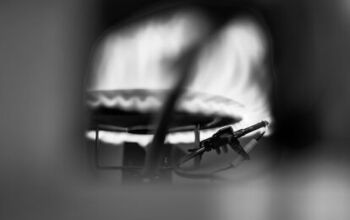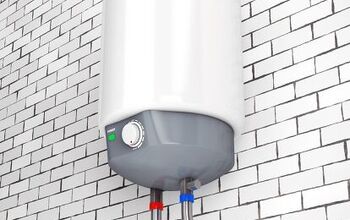Water Heater Pilot Lights But Not the Burner? (Fix It Now!)

Problems with any aspect of your HVAC system can be expensive and frustrating, especially if it involves your water heater. It only takes one part to fail or malfunction to throw off your entire water heater’s performance. So, what should you do if your water heater pilot lights but not the burner?
A water heater pilot lights but not the burner if the thermostat is damaged or over 10 years old. Flame sensors can fail if they are dislodged and the burner won’t detect the pilot light’s flame. Your water heater’s burner won’t work if the gas valve is damaged or the thermostat is unresponsive.
Water heater problems often require professional help, but some fixes are as simple as manually moving the temperature sensor. Problems with your burner can be serious, but they are generally minor and DIYers often fix it without professional help. Follow along as we explore what it means when your water heater pilot lights but not the burner.
Do You Need Water Heater Repair Services?
Get free, zero-commitment quotes from pro contractors near you.

Water Heater Pilot Lights But Not the Burner
Generally, it indicates that you have a bad thermocouple if your water heater pilot lights but not the burner. That isn’t always the case though and you must inspect your water heater before you order a replacement thermocouple. You don’t need to be a plumber or electrician to inspect your water heater and diagnose the problem.
It is typically easy to diagnose the problematic component in your water heater if you simply look for rust. Rust can easily form on several parts of a water heater due to prolonged moisture and heat exposure. Parts of your water heater with excessive rust are generally old and or damaged.
However, rust doesn’t always indicate that a part failed, so it’s important to look for other signs such as leaks or strange noises. Look at the placement of parts such as the flame sensor to make sure that it is where it should be. It is helpful if you’ve worked with a water heater before, but you can diagnose the problem if you understand the 5 main causes for burner problems.
Possible Causes
A water heater’s burner can fail when the pilot light works due to anything from a bad thermocouple to a damaged gas valve. You don’t need to be a plumber or electrician to inspect your water heater and discover the root of the problem. Let’s take a look at the main reasons why your water heater pilot lights but not the burner.
1. Bad Thermocouple
The most common reason that a water heater pilot lights but not the burner is that the thermocouple is bad. Plumbers and electricians can easily replace your thermocouple, but it’s ideal to inspect it first. Shut off your gas valve before you do anything so that your water heater is safe to work.
Remove the cover plate and inspect the thermocouple for physical damage. Depending on the age of your water heater, you will likely find rust around your thermocouple. Rust isn’t always a bad thing, but excessive rust can prevent your thermocouple from working properly.
It may not be worth it to remove the rust if your thermocouple is completely covered. The damage is often already done by that point, and you will likely need to replace it entirely. It costs an average of $212 to replace a thermocouple, but you could spend as much as $320 or more with professional help.
2. Thermostat Malfunction
A thermostat can malfunction just like any other electrical appliance, and it can affect the burner. Thermostats tend to lose their accuracy over time and can eventually hinder your water heater’s performance. Your pilot light may work, but the burner may not if the thermostat can’t communicate with the heater properly.
Luckily, this is an easy fix and simply requires that you adjust your thermostat. Set your thermostat to its “away” or “vacation” setting and adjust the temperature. Inspect the burner and pilot light to see if they work properly. The burner on your water heater shouldn’t stay on all the time, but it should at least turn on when you need it to.
Homeowners can expect their thermostats to last 10 years, but they often malfunction before that. You may need to replace your thermostat if you notice that it affects the burner’s performance. Other signs of a bad thermostat include temperature drops, increased energy bills, and the inability to control the HVAC system.
3. Damaged Gas Valve
Gas valves are one of the most important components of a water heater. A pilot light may work just fine but the burner won’t work if the gas valve is stuck or damaged. Inspect the gas valve and look for rust or debris that could obstruct it.
A burner will only work if the system engages the gas valve, and it requires an electrical current. The electrical current goes between the pilot head, thermocouple, and gas valve. Any interruption in the electrical current between each component can cause the gas valve to fail.
Physical wear and tear can cause your gas valve to malfunction, and that occurs over time. Eventually, gas valves can either wear out or rust and debris can obstruct them. Carefully try to remove rust, or simply replace the gas valve altogether if it is beyond repair.
4. Faulty Sensor
Each water heater has a sensor that senses the heat and flame that your pilot light produces. Your thermocouple won’t work properly if the heat sensor malfunctions. The water heater burner won’t work if the thermocouple doesn’t detect the heat from the pilot light.
A temperature or flame sensor is small and light compared to other components in a water heater. It is easy for a temperature sensor to knock loose, especially when you work on other parts of the system. Luckily, you may be able to fix the problem if you gently move the sensor by hand so that it is in line with the pilot light flame.
However, you must make sure that it is safe to do so first. You must turn off the gas valve and allow the water heater to cool down before you adjust the temperature system or you may get burnt. Turn the system back on, check the pilot light, and make sure that your burner works now.
5. Old Water Heater
Outdated water heaters can malfunction in every way, and that includes problems with the burner. Several signs such as leaks, rust, and banging sounds can tell you that your water heater is too old to function properly.
Water heaters last for 10 years on average, but they can start to go bad around 8 years or before. You can ensure that your water heater lasts up to 15-20 years if you flush it once or twice per year. It costs an average of $100 to flush a water heater with professional help, but it is an easy DIY project.
You need to replace your water heater when you approach the 10-12 year mark, or as soon as it goes bad. Minor fixes like a bad thermocouple or temperature system don’t mean that you need to replace it entirely. However, you’ll need to replace it when repairs cost more than it’s worth to replace the water heater. It costs an average of $400 to replace a water heater.
How Long Does a Thermocouple Last?
Thermocouples last for an average of 10 years, but it varies based on maintenance and how old the water heater is. It is common for a homeowner to go through 2 or more thermocouples in their water heater’s lifespan. Ideally, a thermocouple will last as long as your water heater if you have a standard model with a tank.
However, many modern water heaters are built to last for 20 years, especially tankless models. That doesn’t always apply to all of the water heater’s components, however, and the thermocouple could go bad in less than 10 years. Moist conditions can increase the chance that your thermocouple rusts and goes bad long before the water heater does.
What Color Should the Flame be on a Gas Water Heater?
The flame on your gas water heater should always burn blue. A yellow or orange flame can indicate that the natural gas isn’t burning as intended, and you will need to fix it. Orange flames can set off your carbon monoxide detector, and the excess carbon monoxide isn’t safe to breathe.
It is okay if you notice small spots and flares of yellow in your gas water heater’s flame. A blue flame is a sign that you have the right temperature, proper ventilation, and a healthy burner. Inspect your burner when it is off to make sure that nothing obstructs the flame nozzle, and remove any debris to restore the blue flame.
Summing It Up
It typically means that your thermocouple is bad if your water heater pilot lights but not the burner. A thermocouple lasts for an average of 10 years, and you need to replace yours if there is too much rust on it. Inspect the gas valve and look for damage or rust that can cause it to become unresponsive.
Gas valves can get stuck, and you will need to clean the rust off of them or replace it altogether. The temperature sensor can also prevent your burner from lighting if is faulty or outdated. Move the temperature sensor back into place if the burner can’t sense the flame from the pilot light.
A water heater can malfunction if the thermostat is old or damaged. Outdated thermostats cannot properly communicate with parts of an HVAC system including the water heater. Water heaters can last for up to 20 years, but homeowners often replace them at between 10 and 15 years old.
Related Articles

Ryan Womeldorf has more than a decade of experience writing. He loves to blog about construction, plumbing, and other home topics. Ryan also loves hockey and a lifelong Buffalo sports fan.
More by Ryan Womeldorf






















![12 Washing Machine Brands to Avoid [with Recall Data]](https://cdn-fastly.upgradedhome.com/media/2023/07/31/9075781/12-washing-machine-brands-to-avoid-with-recall-data.jpg?size=350x220)




